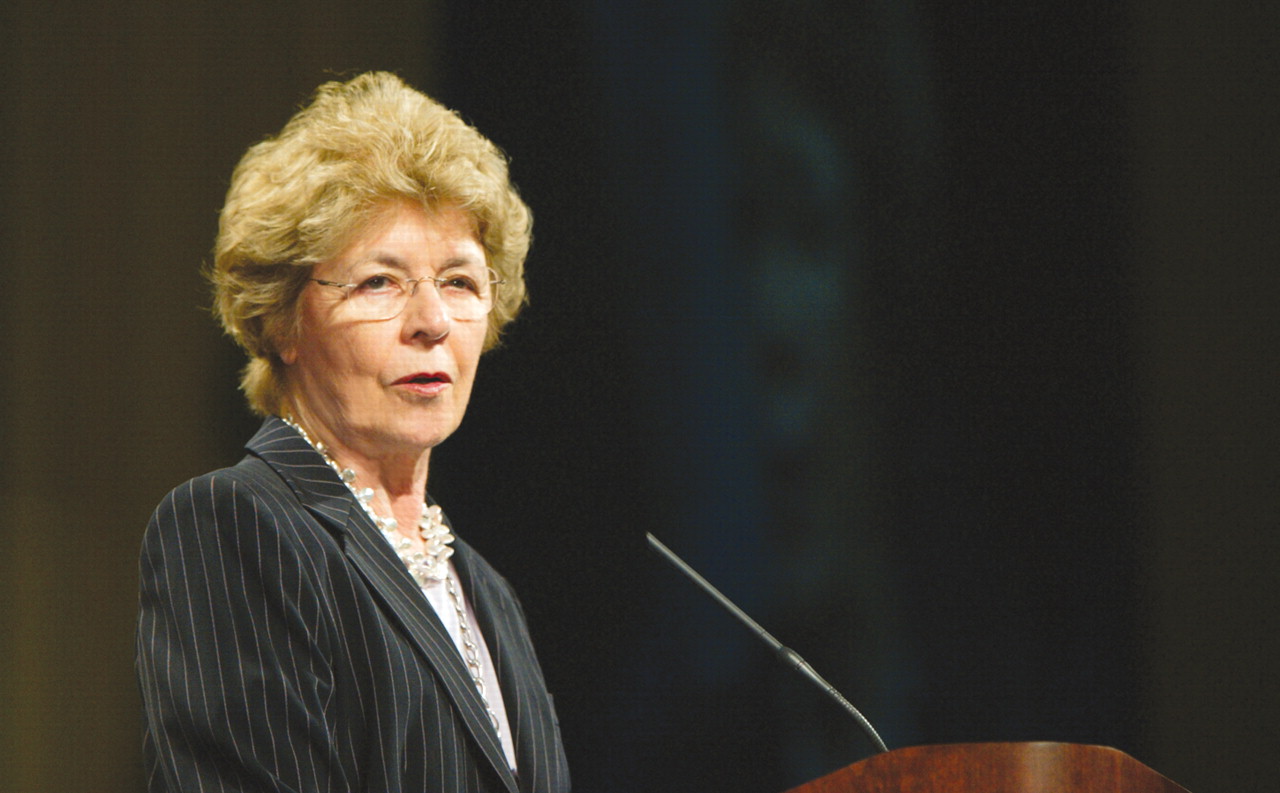Goin Hails Research Advances Merging Mind and Brain
The mind and the brain are one. That was a central message in the address by outgoing APA President Marcia Goin, M.D., at the Opening Session of APA's 2004 annual meeting in New York City. The theme of the meeting was“ Psychotherapy and Psychopharmacology: Dissolving the Mind-Brain Barrier.”

APA President Marcia Goin, M.D., addresses about 2,200 APA members and their guests at the Opening Session of APA's 2004 annual meeting, which was held last month in New York City. Coverage of the meeting begins in this issue of Psychiatric News.
In a speech outlining the triumphs of psychiatry and the challenges still confronting the profession and patients, Goin emphasized the growing awareness—now virtually a scientific consensus—that the division of mind and brain is an artificial one.
“A superb medical scientific achievement for 2003, identified by the prestigious journal Science, lies in the ongoing research studying the complex interplay between genetic and environmental risk factors in the development of mental illness,” Goin told APA members and other attendees. “This work ranks as second in all of science, just behind the cosmological research that has captured the essence of the universe.
“There is great promise in the research developments that continue to unfold the mysteries of gene expression. Neuroimaging reveals the impact on the brain of mood, stress, and a plethora of human emotional reactions. Research paradigms that include affective tasks and the neurocircuitry of psychotherapy responses are all part of this broad picture.”
Goin said the research that is dissolving the mind-brain barrier should be translated into treatment practices, supported by a health care system that recognizes the importance of the doctor-patient relationship.
“PET scans, MRIs, and gene studies are important,” she said.“ But when it comes to understanding who the person is who is experiencing the illness—what is stressful for one person and different for another— the personal interactions and therapeutic alliances are imperative. Emotions affect gene expression, and what is emotionally stressful for one person is not the same for another.
“We remain determined to fight to preserve our ability to spend time with patients,” she continued. “There is no other way to understand their constellation of symptoms in the context of their life histories, genetic background, family interactions, cultural influences, intrinsic intelligence, education, work histories, and past psychiatric interventions. This is not an extravagance; it is a diagnostic and therapeutic imperative.”
At the same time, public budgets for treatment of the most severely mentally ill people continue to be eroded, and Goin drew special attention to their growing numbers in the nation's jails and prisons.
She highlighted a new APA report titled “Mental Illness and the Criminal Justice System: Redirecting Resources to Achieve Cost-Effective Rehabilitation and Reduced Recidivism,” which was released at the meeting (see Original article: page 4).
“The Los Angeles County Jail is now considered to be the largest psychiatric hospital in the country,” Goin said. “Approximately 2,500 of its inmates are being treated for mental disorders at any one time. Fortunately, in the late 1990s a grand jury investigation resulted in upgrading the psychiatric care in the county jail, and it is now considered one of the best psychiatric hospitals in the country.
“Following my visits to the jail, I remain haunted by memories of the mentally ill inmates in the holding area,” she said. “A young woman screaming at unseen visions, a middle-aged man cringing in terror from paranoid delusions—young and old, male and female, visibly suffering in their mental distress.
“Is jail really our nation's preferred institutional treatment of choice?” Goin asked.
American psychiatry also has a stake in the mental health problems that exist outside the nation's borders.
Goin reported on a meeting that she had attended in Cairo in July 2003 convened by the Mediterranean Division of the World Health Organization and the World Psychiatric Association to discuss mental health and rehabilitation in Iraq (Psychiatric News, September 5, 2003).
“Health personnel in Iraq face an acute shortage of human and medical resources, the consequences of years of prolonged conflict and violence worsened by Saddam Hussein's diversion of oil-for-food funds into the building of huge, ostentatious palaces,” Goin said.
“There are grave problems including security, economic instability, power-grid failures, malnutrition, unsafe water, and a severely decimated health care delivery system,” she said. “But the conference reconfirmed that mental health must be a priority public health issue in any rehabilitation effort.”
Goin noted that this consensus was echoed by Health and Human Services Secretary Tommy Thompson, who, when asked by a CNN reporter during a trip there to name the most important health priorities in Iraq, responded that there was “hardly any treatment whatsoever for mental illness.”
Goin called it “heartening” to know that the secretary regarded mental health as second only to infant mortality. “Mental health is no longer incorrectly viewed as a luxury,” she said, “but as a foundation for a functional society.” ▪



